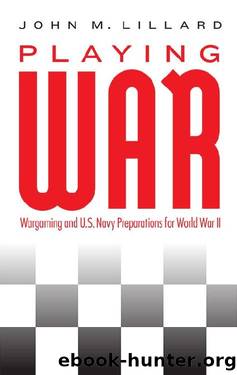Playing War by John M. Lillard

Author:John M. Lillard [Lillard, John M.]
Language: eng
Format: epub
Tags: HIS027150 History / Military / Naval, HIS027110 History / Military / United States, HIS036060 History / United States / 20th Century
ISBN: 9781612347738
Publisher: Potomac Books
Published: 2016-04-30T22:00:00+00:00
Fig. 20. A blueprint of moves 38 through 40 of OP-IV played by the class of 1928. The BLUE fleet and train are in the center and moving northwest, while the ORANGE fleet is attacking BLUE from the west and south. U.S. Naval War College, âBlueprint Record of Moves, OP IV 1928; Moves 38â40, 25 March 0815 to 25 March 0830,â Folder 1382-V2, Box 41, RG4, Publications, 1915â77, NHC.
The lengthy âConclusions and Lessons Learnedâ report from OP IV was not signed, but the author was most probably Captain John W. Greenslade â26, the Division C (Movement) chief and the game director of operations. His report differs greatly from Harris Laningâs matter-of-fact âHistory and Tactical Critiqueâ reports for the class of 1923 in its focus on broader, more subjective areas. Some of this difference could be due to improvements in record keeping; the 1928 blueprint records of moves are much more detailed and heavily annotated than the 1923 charts, so it is possible that Greenslade did not feel the need to provide a move-by-move narrative as Laning did. Whatever the reason, Greensladeâs critique is less a narrative than an essay. He started with a rambling recap of the school year and then discussed his philosophy about the relationship between wargaming and war planning, and his view of the benefits of combining strategic and tactical games. He echoed Admiral Pratt by emphasizing the importance of logistics, the specialization of staffs, and the relationships between logistics and fleet commanders, calling the War College emphasis on logistics âprophetic of a changeâ in the rest of the navy25
But once he was finished with this general preamble, Greenslade critiqued the maneuver in specific and blunt terms. He was especially definitive regarding the viability of BLUE strategy. Greenslade declared that while a fleet of sufficient size to defeat ORANGE could be sortied âpromptly,â the odds of BLUE forces in the Philippines being able to hold out in and around Manila until the fleet arrived were remote unless those forces were greatly reinforced prior to hostilities. Even this possibility he dismissed as âincorrigibly optimistic.â26 Greenslade next went beyond strategy to make remarkably prescient recommendations for changing the tactics and organization of the aviation assets of the relief force to increase their autonomy and overall effectiveness. His comments, coming as they do from a senior officer who spent his career in surface ships, are especially significant, as he emphasized the need for the BLUE surface units to operate under an umbrella of what would later be called air superiority: âIt seems established that BLUE can only hope to make successful operations of retaking the PHILIPPINES from TAWI TAWI by wiping out ORANGE air bases by air in succession and pushing forward the zone in which surface craft may operate. . . . All [non BB or CA aircraft] should be organized in an Air Command from which they operate as a Force or with their carriers as parts of Task Forces as designated by High Command.â27
Greenslade did not restrict his recommendations to the employment of aviation.
Download
This site does not store any files on its server. We only index and link to content provided by other sites. Please contact the content providers to delete copyright contents if any and email us, we'll remove relevant links or contents immediately.
The Radium Girls by Kate Moore(10910)
The Templars by Dan Jones(4191)
100 Deadly Skills by Clint Emerson(4080)
Rise and Kill First by Ronen Bergman(4013)
The Doomsday Machine by Daniel Ellsberg(3734)
The Rape of Nanking by Iris Chang(3518)
Killing England by Bill O'Reilly(3457)
Hitler in Los Angeles by Steven J. Ross(3439)
Stalin by Stephen Kotkin(3087)
12 Strong by Doug Stanton(3059)
Hitler's Monsters by Eric Kurlander(2734)
Darkest Hour by Anthony McCarten(2648)
Blood and Sand by Alex Von Tunzelmann(2610)
The Art of War Visualized by Jessica Hagy(2413)
Hitler's Flying Saucers: A Guide to German Flying Discs of the Second World War by Stevens Henry(2297)
The Code Book by Simon Singh(2211)
The Second World Wars by Victor Davis Hanson(2136)
Babylon's Ark by Lawrence Anthony(2072)
Tobruk by Peter Fitzsimons(2062)
